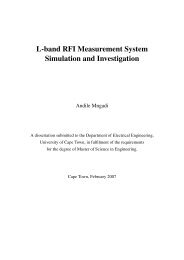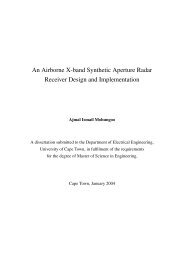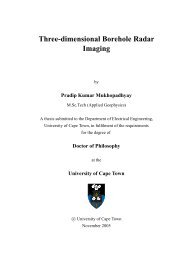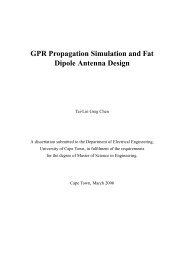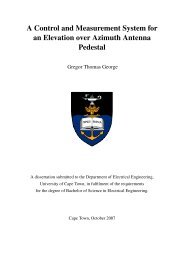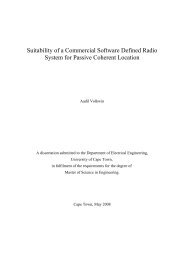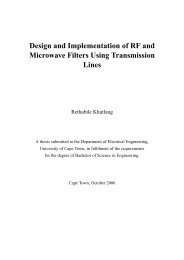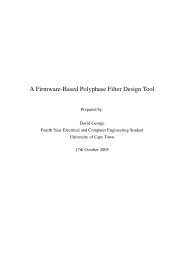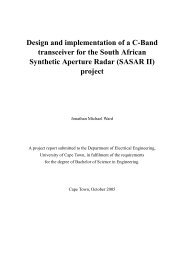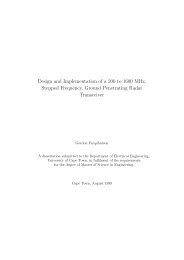Design and Implementation of a Pillbox Antenna for an Airborne ...
Design and Implementation of a Pillbox Antenna for an Airborne ...
Design and Implementation of a Pillbox Antenna for an Airborne ...
Create successful ePaper yourself
Turn your PDF publications into a flip-book with our unique Google optimized e-Paper software.
tion [16].2. The operating centre frequency is set to f ◦ = 9.3GHz.3. The <strong>an</strong>tenna operating b<strong><strong>an</strong>d</strong>width which is determinedby the tr<strong>an</strong>smitter is B = 100 MHz.4. The <strong>an</strong>tenna 3 dB azimuth beamwidth shall be 3.8 ◦<strong><strong>an</strong>d</strong> the elevation beamwidth shall be 25 ◦ .5. The peak power that the <strong>an</strong>tenna system c<strong>an</strong> h<strong><strong>an</strong>d</strong>leis 3.5 kW.6. The <strong>an</strong>tenna should be able to operate at a plat<strong>for</strong>mheight <strong>of</strong> 3000-8000 m. The aircraft cabinis pressurised at the equivalent <strong>of</strong> 8000 feet. The<strong>an</strong>tenna shall be mounted inside the aircraft, pressingagainst the perspex window, to avoid costly airframemodifications.The adv<strong>an</strong>tages <strong>of</strong> using a pillbox <strong>an</strong>tenna <strong>for</strong> radar applicationsare given below [19]• It is easy to design <strong><strong>an</strong>d</strong> the cost <strong>of</strong> production islow.• It is dually-polarized <strong><strong>an</strong>d</strong> it is also a wide b<strong><strong>an</strong>d</strong> <strong>an</strong>tenna.• It has a high power h<strong><strong>an</strong>d</strong>ling capability.2 <strong>Design</strong> <strong>of</strong> <strong>Antenna</strong>2.1 <strong>Design</strong> TheoryThe pillbox design was based on the aperture fieldmethod as well as diffraction theory <strong>of</strong> aperture <strong>an</strong>tennas.By using geometrical optics [6] <strong><strong>an</strong>d</strong> the diffractiontheory <strong>of</strong> <strong>an</strong>tennas we c<strong>an</strong> predict the far-field <strong>of</strong><strong>an</strong> <strong>an</strong>tenna. There is a Fourier Tr<strong>an</strong>s<strong>for</strong>m relationshipbetween the far-field <strong><strong>an</strong>d</strong> the aperture field which is<strong>an</strong>alogous to the relationship between Fourier spectra<strong><strong>an</strong>d</strong> time domain wave<strong>for</strong>ms (even though wave<strong>for</strong>msare one-dimensional). The far-field c<strong>an</strong> be predicted bytaking the Fourier Tr<strong>an</strong>s<strong>for</strong>m <strong>of</strong> the t<strong>an</strong>gential component<strong>of</strong> the E-field. This one dimensional treatment isadequate <strong>for</strong> discussing the pillbox <strong>an</strong>tenna since its directivityc<strong>an</strong> be separable into a product <strong>of</strong> directivities<strong>of</strong> one-dimensional apertures made up <strong>of</strong> the length <strong><strong>an</strong>d</strong>width <strong>of</strong> the aperture [3]. Once the aperture fields arehave been calculated, we use equation 1 to predict thefar-field pattern <strong>of</strong> the <strong>an</strong>tenna in the E <strong><strong>an</strong>d</strong> H-pl<strong>an</strong>es [5][6][7]:E (θ) =∫ x/2−x/2f (x)e jkx sin θ dx (1)Wheref (x) is the aperture field distribution function across theaperture, ‘x’ is the length <strong>of</strong> the aperture <strong><strong>an</strong>d</strong> ‘k’ is thewavenumber.2.2 Offset fed <strong>Pillbox</strong> <strong>Design</strong>Offset prime-focus-reflectors are desirable because <strong>of</strong>the ability to <strong>of</strong>fset the feed enough so that it is notin the way <strong>of</strong> the aperture to cause aperture blockagewhich consequently raises the sidelobe levels. However,<strong>of</strong>fset-fed reflectors with a linearly polarized feedsuffer from higher cross-polarization th<strong>an</strong> axisymmetricreflectors [20]. Here the major design emphasis is onthe choice <strong>of</strong> <strong>of</strong>fset <strong>an</strong>gle or feed pointing <strong>an</strong>gle ψ f toreducing sidelobe levels <strong><strong>an</strong>d</strong> also reduce cross polarizationwithout a sacrifice in gain [20].Offset reflector <strong>an</strong>tennas inherently produce <strong>of</strong>f-axiscross-polarization in the principal pl<strong>an</strong>e normal to the<strong>of</strong>fset pl<strong>an</strong>e. The cross-polarization is a result <strong>of</strong> theasymmetric mapping <strong>of</strong> the otherwise symmetrical patterninto the aperture <strong>an</strong>tenna [2] [18]. We wish to keepthe cross-polarization levels to at least 30 dB belowthe peak <strong>of</strong> the co-polar pattern <strong>for</strong> satisfactory per<strong>for</strong>m<strong>an</strong>ce<strong>of</strong> the <strong>an</strong>tenna [15][18].2.2.1 The GeometryThe geometry <strong>of</strong> the <strong>of</strong>fset fed configuration is shownin figure 2. The primary parameters that we c<strong>an</strong> controlare the degree <strong>of</strong> <strong>of</strong>fset by varying h <strong><strong>an</strong>d</strong> the aiming <strong>of</strong>the feed <strong>an</strong>tenna (the <strong>an</strong>gle ψ). In this paper we considerthe case <strong>of</strong> the more th<strong>an</strong> fully <strong>of</strong>fset feed, h > 0to provide a blockage-free region <strong>for</strong> the structures inthe focal region. In practice in order to keep spill-overlosses reasonable the feed is aimed within the r<strong>an</strong>ge [19][20]:40 ◦ ≤ ψ f ≤ 60 ◦The definitions <strong>of</strong> the symbols used in Figure 2 aregiven below where



